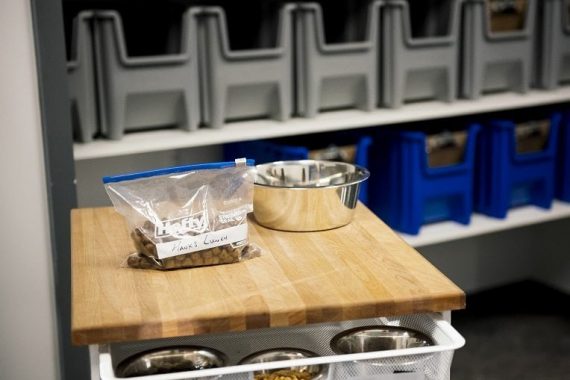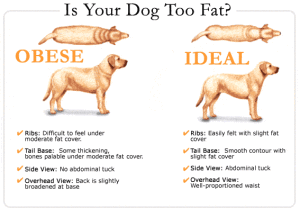Prevent Dog Obesity

Most dogs who live as home pets do not get enough exercise and they’re lucky if they get walked through the neighborhood a couple of times a week. Some dogs spend their entire lives in a yard.
As a result, maybe pups have a weight issue. Statistics show that more than half of the dogs in the U.S. are obese. Their pet parents buy dog food and feed their dog according to the portion sizes indicated by the dog food manufacturer. However, dog food makers are in business to sell dog food—they’re not necessarily in business to keep your dog at his ideal weight. Not to mention the fact that sedentary dogs need less food than active ones, so there’s a big difference between a dog who plays all day with friends at a dog daycare facility and one who sleeps at home all day. Pet parents should be actively monitoring weight with their veterinarian and feed more, or less, depending on the amount of activity the dog gets in their daily lives.
Obesity causes the same types of diseases in dogs that it causes in humans: diabetes, heart disease, hypothyroidism, and arthritis. Dogs with these conditions often have a shorter life span than dogs who are in better physical condition. Your dog’s condition is measurable by a Body Condition Score (BCS), which is what vets use. In this score, 4/9 to 5/9 are considered normal scores, while 6/9 to 7/9 are overweight and 8/9 to 9/9 indicate obesity. Obesity is defined like it is for humans, as more than 30% over normal weight.
You can tell if your dog is obese simply by feeling his chest and seeing if you can feel his ribs easily through his skin, like you can easily feel the bones in the back of your hand. If you have to search for his ribs through a thick layer of fat, then he is overweight. His ribs, spine, and hips should not be visible in most dogs, as this is generally a sign of being underweight. If you are unsure, ask your vet what your dog’s ideal weight should be.
If you think your dog needs to go on a diet, follow these steps:
- Ask the vet what your dog’s ideal weight should be and the best exercises or activities your pup should do to maintain a healthy weight.
- Once you’ve found the ideal weight for your dog, read your dog food label and speak with your veterinarian. The label will report the number of kcals (calories) in a cup of food.
- Don’t forget to include treats in the daily calorie count. You can also use their dog food as their treat—simply portion out from the overall total and use this a way to reward and praise them. They won’t realize you’ve made a healthy swap for them!
- Make a daily plan of exercises you plan to do with your dog to keep your dog active and healthy.
 If you need help getting your dog more active or introducing them to some new friends, Dogtopia can help. We offer a safe and fun-filled environment with an action-packed daily schedule to ensure your furry friend gets plenty of exercise and socialization while you are at work or running errands during the day. Learn more about our dog daycare services here or contact us for more information.
If you need help getting your dog more active or introducing them to some new friends, Dogtopia can help. We offer a safe and fun-filled environment with an action-packed daily schedule to ensure your furry friend gets plenty of exercise and socialization while you are at work or running errands during the day. Learn more about our dog daycare services here or contact us for more information.












